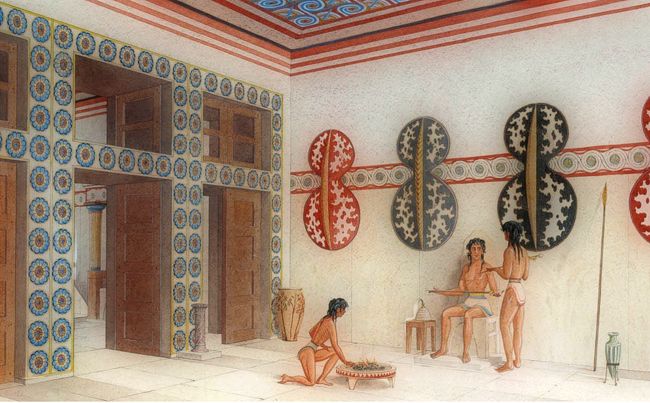The celebrated palace of Knossos, the most magnificent Minoan monument, residence of the
mythical king Minos, was for about three hundred years - from 1650 BC to 1350 BC - the
main centre of power in Crete. Its history is even longer and its architecture as complex as its
functions. The palace was built early in the second millennium and destroyed two hundred years
later, at the end of the Palaeopalatial period. It was rebuilt in a more splendid form, suffered fresh
disasters and repairs and was ultimately destroyed by fire in 1350 BC. For the last hundred years
of its life, it was the seat of the Mycenaean dynasty that had succeeded the Minoan kings after the large scale disaster in Crete in 1450 BC and the collapse of the Minoan palace system.
Built with sumptuous materials, on the basis of an intricate and coherent architectural design,
using highly advanced construction techniques, and boasting an impressive water supply and
sewage system, the palace of Knossos, twice the size (ca. 22.000 sq. meters and 1.400 rooms) of the other two large palaces at Phaistos and Malia, is the monumental symbol of the Minoan civilisation.
Labyrinthine corridors and the famous Grand Staircase linked the multiple areas of buildings from three to five storeys high that
were situated around the Central Court.

The west wing housed the religious and cult activities; in
the east wing were the royal apartments. The palace contained large storerooms in which were
enormous storage jars (pitharia) and various workshops. The South Propylaeum and North
Entrance were fortified by colonnaded bastions. Public events were held in the so-called Theatre
with the Royal Road and the open-air Courts. The Throne Room, with its wall paintings and
contiguous underground purification tank (or "Lustral Basin'), was the most official venue for
religious activities. This was where the famous "Throne of Minos' was located. the alabaster throne on which - according to Arthur Evans, the archaeologist who excavated Knossos - sat the "King - Priest', the secular and religious leader, and head of the senior officials who were seated on the benches surrounding the throne.
Many of the exceptional exhibits in the Herakleion Museum have come from the excavation of
the palace and the large structures around it, including some of its most famous works, symbols of Minoan civilisation, such as the Snake Goddesses and other findings from the Sacred Treasuries, the rhyton in the shape of a bull`s head, the ivory bull - leaper, the relief wall painting of the "Prince with the Lilies', the wall painting of the bull - leaping, and others.